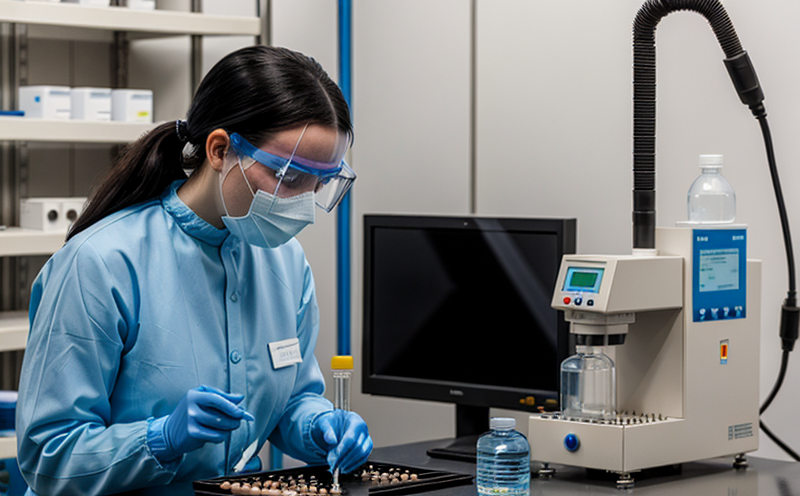EPA 8270 Semi Volatile Organic Compound Testing
The EPA 8270 method is a critical tool in the analysis of semi-volatile organic compounds (SVOCs) present in various environmental and pharmaceutical samples. This testing protocol ensures regulatory compliance for companies involved in the research, development, manufacturing, and distribution of pharmaceutical products.
SVOCs are a class of contaminants that do not readily dissolve in water but can be adsorbed onto soil or suspended particles in water. They are often present in pharmaceutical formulations as impurities or by-products of synthesis processes. The presence of SVOCs in pharmaceutical compounds can lead to potential health risks and regulatory non-compliance.
The EPA 8270 method is designed to meet the stringent requirements set forth by environmental protection agencies around the globe, ensuring that the testing process adheres to international standards such as ISO, ASTM, EN, IEC, and others. This protocol allows for precise quantification of SVOCs in complex matrices like water, soil, air, and pharmaceutical formulations.
The testing procedure involves several critical steps: sample collection, extraction, purification, concentration, derivatization (if necessary), injection into a gas chromatograph/mass spectrometer (GC/MS) or liquid chromatography/mass spectrometry (LC/MS) system, and data analysis. Each step is meticulously controlled to ensure accurate and reliable results.
The EPA 8270 method is particularly useful for identifying and quantifying SVOCs in pharmaceutical formulations to ensure they meet strict purity standards set by regulatory bodies. It helps companies maintain compliance with stringent environmental regulations, safeguard public health, and protect the environment from potential hazards associated with SVOCs.
The testing process begins with sample collection, which can be challenging due to the volatility of the compounds being analyzed. Proper sampling techniques are crucial to avoid contamination or loss of analytes during the extraction phase. After collection, samples undergo thorough preparation, including filtration, solvent-based extraction, and cleanup steps to remove interferences.
The next step involves derivatization if necessary. This process is essential for improving detection sensitivity by converting SVOCs into more stable derivatives that are easier to analyze with GC/MS or LC/MS systems. Once the samples are prepared, they are injected into the chromatography system where separation of compounds occurs based on their physical and chemical properties.
The final step involves data analysis using advanced software tools designed specifically for GC/MS/LC/MS instruments. This process involves identifying peaks corresponding to SVOCs within a given matrix and calculating concentrations according to calibration standards provided by the method.
Scope and Methodology
| Component | Description |
|---|---|
| Sample Preparation | Involves filtration, extraction, and cleanup to ensure pure samples for analysis. |
| Extraction | Uses solvent-based methods to isolate SVOCs from the matrix. |
| Purification | Involves techniques like solid-phase extraction (SPE) or liquid-liquid extraction (LLE). |
| Concentration | Bridges the gap between sample volume and analysis. |
| Derivatization | Makes SVOCs more detectable by converting them into stable derivatives. |
| Instrumentation | GC/MS or LC/MS systems for separation and identification of compounds. |
| Data Analysis | Identifies peaks corresponding to SVOCs and calculates concentrations. |
International Acceptance and Recognition
- EPA 8270 is widely recognized by regulatory bodies worldwide, including the FDA and EMA.
- The method is compliant with international standards such as ISO, ASTM, EN, IEC.
- It ensures consistent quality across different regions through standardized procedures.
This comprehensive acceptance makes EPA 8270 a reliable choice for pharmaceutical companies seeking to ensure their products meet strict global regulatory requirements. The method is also recognized by key industry organizations, ensuring that results are credible and universally accepted.
Competitive Advantage and Market Impact
- EPA 8270 provides a competitive edge by offering precise quantification of SVOCs, ensuring product purity and safety.
- The method supports compliance with stringent regulatory requirements, reducing the risk of non-compliance penalties.
By leveraging EPA 8270, companies can demonstrate their commitment to environmental sustainability and public health. This commitment enhances brand reputation and strengthens market position, making it a crucial tool for pharmaceutical manufacturers looking to stay ahead in an increasingly regulated industry.





